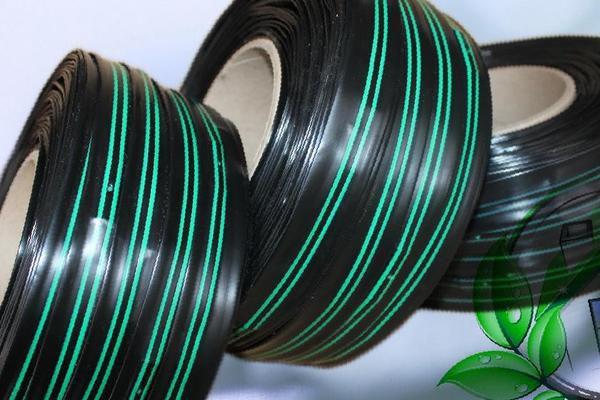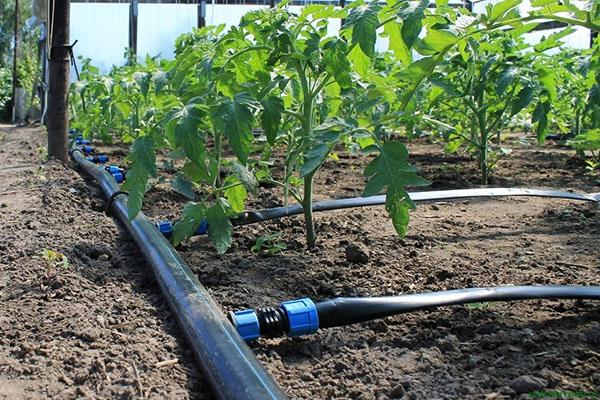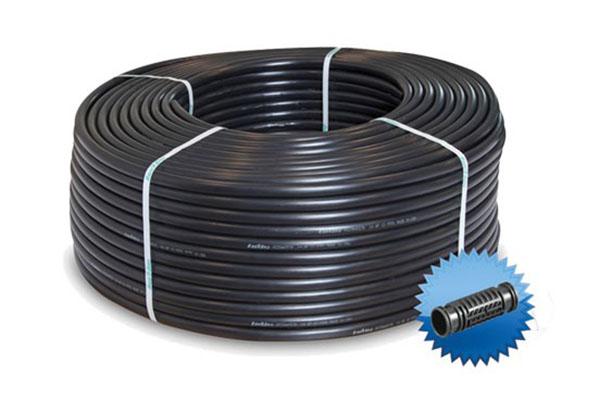Drip irrigation tape: types, design features, selection rules
 Tape for drip irrigation is actively used when organizing auto fuel for plants in greenhouses and on open ground. The quality of irrigation of the site, the level of water saving and, as a result, the owner's finances depend on the competent choice and method of operation of this structural element.
Tape for drip irrigation is actively used when organizing auto fuel for plants in greenhouses and on open ground. The quality of irrigation of the site, the level of water saving and, as a result, the owner's finances depend on the competent choice and method of operation of this structural element.
Benefits of drip irrigation

The use of drip tape provides:
- significant increase in productivity;
- reducing the incidence of crops;
- slower growth and reduced spread weeds.
Drip irrigation excludes the appearance of superficial leaf burns, prevents the leaching of minerals from the soil. But the main advantage of this design is the ability to automate watering plants according to a user-defined program.
Types and design features
 The drip tape is a polymeric flexible tube with holes. The operational characteristics of the irrigation system depend on their device, namely: the irrigation process, fluid consumption, operability and durability. The domestic agricultural market offers the consumer an impressive range of products. Among the most popular options are obsolete labyrinthine, more modern slotted and the most "advanced" - emitter types of drip tape. Each variety has its own characteristics, advantages and disadvantages. Let's consider them in more detail.
The drip tape is a polymeric flexible tube with holes. The operational characteristics of the irrigation system depend on their device, namely: the irrigation process, fluid consumption, operability and durability. The domestic agricultural market offers the consumer an impressive range of products. Among the most popular options are obsolete labyrinthine, more modern slotted and the most "advanced" - emitter types of drip tape. Each variety has its own characteristics, advantages and disadvantages. Let's consider them in more detail.
Labyrinth
 The simplest and most affordable option for organizing drip irrigation. A zigzag channel (labyrinth) is located on the surface of the tape, which prevents the rapid movement of water. The main advantages are fast water heating and low cost. The main disadvantages are: insufficient productivity and uneven distribution of liquid between crops.
The simplest and most affordable option for organizing drip irrigation. A zigzag channel (labyrinth) is located on the surface of the tape, which prevents the rapid movement of water. The main advantages are fast water heating and low cost. The main disadvantages are: insufficient productivity and uneven distribution of liquid between crops.
Crevice
 The tube is equipped with an internal zigzag channel, which is responsible for reducing the speed of water movement and even distribution between the holes. Slotted drip tape has a lot of advantages compared to labyrinth models, among which the most significant are reliability in operation and easy installation.
The tube is equipped with an internal zigzag channel, which is responsible for reducing the speed of water movement and even distribution between the holes. Slotted drip tape has a lot of advantages compared to labyrinth models, among which the most significant are reliability in operation and easy installation.
The main disadvantage of slotted tape for irrigation is the need to organize a high-quality water filtration system in order to reduce the likelihood of clogging the holes.
Emitter
 Structurally, the emitter-type drip irrigation tape is not equipped with a channel that slows down the water flow. The "labyrinth" is located inside special devices - emitters, which are installed throughout the tube.
Structurally, the emitter-type drip irrigation tape is not equipped with a channel that slows down the water flow. The "labyrinth" is located inside special devices - emitters, which are installed throughout the tube.
The main advantage of this design is the self-purification of water from suspended matter by the swirls created inside the droppers.
Thanks to this technical solution, the service life of the drip tape is significantly increased, which is important when creating an effective, and most importantly economical automatic irrigation systems.
Criterias of choice

When buying a drip tube, you need to pay attention to its type, bore diameter, wall thickness, pressure parameters, hole pitch:
- View. Today, most gardeners choose modern slotted or more expensive emitter models.
- Inner diameter.It has a direct impact on the length of the branch and water productivity. Most models are available in two diameters: 16 and 22 mm. If a branch up to 300 m is planned, then a tube with a passage section of 16 mm should be chosen. If its length is from 300 to 750 m, then you should opt for a product with a diameter of 22 mm.
- Wall thickness. This parameter affects the strength characteristics and cost of the model. The thickness can vary from 0.1 to 0.375 mm. Which tape is best for drip irrigation? Everything is simple here: the thinner the wall, the cheaper the model and more susceptible to mechanical damage. Thicker hoses are best used for irrigating crops with long growing seasons in rocky areas. Thin-walled tubes are recommended for irrigation of early maturing crops planted in areas with normal soils.
- Pressure range. Depending on the wall thickness, the product can withstand relatively low loads. The maximum pressure for drip tape ranges from 0.7 to 1 bar. The minimum response threshold for the emitters is between 0.1 and 0.5 bar.
The choice of the distance between the holes depends on the method of planting and the characteristics of growing crops. If they are planted close to each other (bow, carrot etc.), you should give preference to tapes with an emitter pitch of 10-15 cm.Products with a hole pitch of 20 cm are suitable for watering cucumbers. The belts with a 30 cm emitter pitch will find their application when irrigating areas with tomatoes and eggplants. A step of 40 cm is suitable for watering melons and gourds.
Drip irrigation tape and water flow

Choosing a drip tape, you should start from the required water consumption, which, in turn, depends on the structure of the soil and the moisture consumption of the crops grown:
- Irrigation of sandy and well-drained areas may require 2 to 4 liters / hour of water.
- Consumption 1 - 1.5 l / h is typical for medium soils.
- Less than 1 liter / hour will be required to water an area with clay soil.
All drip tape on sale in the domestic market is accompanied by an instruction indicating the flow rate of water through the emitters. This parameter is decisive in determining the efficiency of a drip irrigation system.
Drip irrigation tape connection
 Drip tape cannot be used for irrigation without a reduction gear in the main water supply system. The most common connection of drip tape is to a container that is located at some elevation.
Drip tape cannot be used for irrigation without a reduction gear in the main water supply system. The most common connection of drip tape is to a container that is located at some elevation.
Each meter the tank is raised relative to the irrigation system gives a pressure increase in the belt of 0.1 bar.
An inset of a branch pipe with a ball valve into the container is made a few cm above the bottom. This solution reduces the likelihood of mechanical inclusions entering the tape, and, as a result, clogging of the emitters. Further, a filter element is attached to the branch pipe, which retains suspensions in the water. After the filter, a horizontal pipe section is installed, into which smart connectors are cut. A drip tape is connected to them, the end portions of which must be muffled.